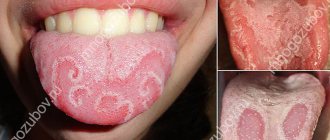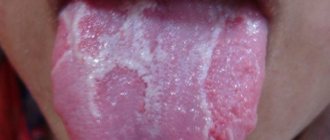What is geographic language
Geographic tongue (desquamative glossitis) is an inflammatory disease of the mucous membrane of the tongue, which is normally covered with small papillae (hairs). With the development of pathology, the latter become deformed, the surface becomes smooth and red. In appearance, the lesions resemble a geographical map with islands.
Inflammatory foci have elevated, clearly defined boundaries. They differ in their ability to heal in one place and move to another. More often there is an alternation of compactions with sagging mucous membranes.
Before prescribing treatment for a disease, it is necessary to accurately determine the causes that led to the pathology and, if possible, eliminate them, since this problem is not only cosmetic in nature, but can also lead to serious consequences.
Gunterovsky
Möller-Gunther glossitis is a form of the disease in which the patient has a visually smooth tongue. Main reasons: deficiency of folic acid and vitamin B12, anemia. The photo shows a characteristic picture of the pathology - the affected organ shines and looks like it is varnished. This occurs due to atrophy of the papillae of the tongue and thinning of the epithelial cover. When touching and mechanical impact there is a sharp pain.
It is interesting that the characteristic signs of this variety can appear long before the symptoms of the underlying disease (in particular, anemia) leading to glossitis are identified.
With this pathology, the tongue shines
“One morning I woke up, as if nothing had happened, went to brush my teeth and, opening my mouth, was stunned - my tongue was crimson and shiny, slightly swollen. It felt like it had been rubbed with sandpaper for a long time, and then covered with a layer of transparent varnish. Horror! There was no pain or other signs. I waited a few days, nothing changed, in principle, I immediately started reading what it could be. Then I went to see a therapist. After the examination, a diagnosis was made - “Gunther-Möller glossitis” and, it seems, “tongue atrophy”. In principle, the treatment was quite simple, but it is not known what would have happened if I had not been such an alarmist and had not immediately gone to specialists...”
Olga, review from woman.ru
Causes
Today, the disease is quite common, but despite this, it has not been fully studied, especially the etiology. It was possible to identify a number of reasons that contribute to its development:
- Diseases of the digestive system.
- Pathologies of the thyroid gland.
- Liver diseases.
- Disorders in the circulatory system.
- Malignant and benign tumors.
- Autonomic-endocrine disorders.
- Infectious processes.
- Autoimmune diseases.
- ARVI, ARZ.
- Pathologies of the nervous system.
- Allergic diathesis.
- Pathologies occurring in the oral cavity.
- Hereditary genetics.
- Avitaminosis.
- Chronic skin diseases.
- Stressful situations.
- Diabetes.
- Long-term therapy with antibiotic drugs.
In childhood, desquamative glossitis can manifest itself against the background of general diseases of the liver, kidneys, pancreas, spleen, and desquamative glossitis. In girls, it is more often observed before the first menstruation or during bleeding.
The disease can occur either independently or as a symptom of a concomitant disease. Therefore, it is divided into primary and secondary desquamative glossitis.
Primary glossitis most often occurs when the tongue is injured by sharp edges of teeth or dentures, as well as from chemical or thermal burns. In young children, geographic tongue is diagnosed during teething.
The development of the secondary form occurs as a result of pathological reactions in the human body. This is observed due to increased sensitivity to changes in the mucous epithelium of the tongue. Such changes are promoted by chronic diseases of the liver, gall bladder, severe vitamin deficiency and others. The pathology often begins with colds, scarlet fever, measles, and typhoid fever.
Types of disease
Depending on the prevalence of the process and the predominance of a certain nature of changes, the following are distinguished:
Catarrhal glossitis
It is manifested by swelling, redness of the tongue, and the appearance of plaque on its surface, but the process does not extend to its deeper layers. Most often, catarrhal glossitis occurs with superficial injuries and burns of the tongue (chemical, thermal), oral candidiasis (disturbance of the balance of normal microflora), various forms of stomatitis, infectious diseases (viral and bacterial nature), as well as with a number of diseases (anemia, hypovitaminosis , metabolic disorders, diseases of the digestive system, etc.).
Ulcerative glossitis
It is usually manifested by the formation of single or multiple small ulcers on the tongue (the so-called aphthae, hence another name for it - aphthous glossitis). Ulcerations are often accompanied by bleeding, severe swelling, severe pain and deterioration in general condition. This type of glossitis can develop from catarrhal glossitis, and also be a manifestation of diseases of the oral cavity, gum diseases, and diseases of internal organs.
Purulent-phlegmous glossitis
It is a severe form of inflammation, spreading not only to the deeper layers of the tongue, but also to other tissues of the oral cavity; the nearby lymph nodes are also involved in the process. In this case, the patient’s condition is serious, with severe intoxication and elevated temperature, so such patients are usually treated promptly. Antibiotics for this glossitis are a mandatory component of treatment.
Symptoms
Geographical language is manifested by the following features:
- Cloudiness of the mucous membrane - during the initial development, a whitish coating with a gray tint appears. The lesion is small - no more than three millimeters.
- Detachment of the papillae - with further development, the papillae desquamate, and underneath there is an area of bright red color, which stands out strongly against the general background of the tongue. Such an “island” can grow and move, but the boundaries remain clear.
When the focus becomes as large as possible, the boundaries are not so clearly defined and begin to blur. In the center of the lesion, the mucous membrane takes on a normal state, and along the borders keratinization and peeling (desquamation) are observed. Since the affected areas are capable of displacement, desquamation is layered one on one.
That is, new lesions appear on old lesions, the mucous membrane becomes similar to a geographical map. This process is characterized by the fact that all areas of the tongue are affected, excluding the lower part. And this picture can change daily.
Desquamative glossitis manifests itself without pronounced symptoms, so many people learn about the disease only when examined by a doctor. Occasionally, patients complain of itching and burning, discomfort while eating, and impaired sensitivity to the taste of food.
All about the symptoms and treatment of glossitis
The main symptom of the disease is the appearance of the tongue. Some patients, as a result of the disease, develop a pathological fear for their life, a panicky fear of the appearance of a malignant tumor (cancerophobia).
The development of pathology is influenced by severe stress, and it does not matter what emotions a person experiences: positive or negative. In approximately half of the cases, a parallel course with the folded tongue is observed.
Despite the fact that the pathology does not bring much discomfort, the patient is frightened by the very sight of the affected organ, which is stressful and accordingly worsens the course of the disease.
A feature of desquamative glossitis is its complete disappearance, more often for a long time, but then the symptoms reappear.
Features of glossitis during pregnancy
The causes of glossitis of the tongue in pregnant women are due to the fact that the immune defense weakens to allow the fetus to develop, which means that the body during this period becomes practically defenseless in the face of various bacteria and viruses. The second risk factor is a lack of vitamins and minerals obtained from food.
According to statistics, most often pregnant women experience a picture of desquamative and Gunter's glossitis. Symptoms that should alert you during pregnancy include:
- Profuse drooling. During the period of bearing a child, a woman already secretes a larger amount of saliva than usual, but a sharp increase may indicate the onset of glossitis.
- "Lacquered Tongue" A specific symptom that indicates the development of B12 deficiency anemia.
- Color change. White spots on the surface of the tongue alternate with spots of rich red color.
- Refusal of food. Acute glossitis in pregnant women is characterized by severe pain in the tongue during chewing and speaking, which, among other things, affects appetite.
As for the treatment of glossitis in pregnant women, the safety of the fetus comes first. Therefore, all therapy is exclusively local in nature (sprays, rinses), eliminating the penetration of the drug through the placenta. It is recommended to adjust your diet in such a way as to remove any foods that irritate your tongue.
Attention!
In order to avoid complications that can negatively affect the health of the fetus, treatment of glossitis during pregnancy must be carried out under the supervision of an obstetrician-gynecologist monitoring the woman.
Diagnostics
Making a correct diagnosis is not particularly difficult, so any doctor can recognize the geographic language based on the following studies:
- Collection of anamnesis, which is based on the patient’s complaints and examination data.
- General analysis .
- Bacteriological culture to detect pathogenic microorganisms and determine the causative agent of the disease.
- Polymerase chain reaction (determination of the pathogen by DNA).
- Enzyme immunoassay (presence of non-standard antibodies).
- Scraping the mucous membrane of the tongue to identify treponema pallidum (if syphilis is suspected).
- analysis to detect worms.
To differentiate from other diseases, the doctor focuses more on the movement of lesions.
Candidamycotic, or yeast
The inflammation on the tongue shown in the following photo is caused by yeast-like fungi of the genus Candida. In this case, the entire mucous membrane of the muscular organ is covered with a dense gray coating, hyperemia and swelling are also noted, and the sick person experiences a painful burning and itching, and it is painful for him to eat and chew food. Severe dry mouth is also noted.
The photo shows candidiasis glossitis
Read the article on the topic: 7 colors of plaque on the tongue - how not to miss a dangerous disease.
As you can see, there are a lot of forms of glossitis; there are also herpetic, ulcerative, phlegmonous, and leprosy. Each has symptoms that differentiate it from other types, and each requires immediate treatment. However, in order for the treatment to be correct, it is necessary to understand what exact reason served as the starting impetus for the development of the disease.
Treatment
Treatment is primarily aimed at eliminating the cause (problems with the gastrointestinal tract, bad habits, endocrine disorders in the body).
- Sanitation of the oral cavity – treatment of carious teeth, maintenance of oral hygiene.
- Diet – the patient is prescribed a special diet that does not contain foods and drinks that irritate the oral mucosa. For example, hot, spicy and smoked dishes, carbonated and alcoholic drinks and others.
- Quitting tobacco products.
- Local treatment involves the use of antiseptic rinsing solutions. The most commonly prescribed drugs are Chlorhexidine, Miramistin, Furacilin, and potassium permanganate.
- Novocaine blockades - injections into the area of the lingual nerve (10 injections per course).
- Solutions with an analgesic effect - in the presence of ulcers and erosions. Treated with an antiseptic solution using a tampon.
- Preparations to boost immunity: vitamin complexes, immunostimulants, antihistamines.
- Ointments – have a healing and analgesic effect, applied in the form of applications. The specialist often prescribes Actovegin, Kamistad, Lidocaine.
- Antibiotics - when purulent processes are detected in the oral cavity, regional lymph nodes and tissues: Tetracycline, Doxycycline, Rocephin, Suprax and others. In the most advanced situations, surgical intervention is prescribed.
- Mycotic drugs when fungal microorganisms are detected: Lamisil, Nystatin, Exifin.
Some patients with cancerophobia need psychological help; this requires consultation with a psychologist or psychotherapist.
Purely concrete
The mandatory daily ritual of brushing your teeth should also include a tongue cleansing procedure. The heterogeneous microrelief of this organ, consisting of papillae of different sizes, is an ideal field for the proliferation of pathogenic bacteria.
The most plaque accumulates in the morning. Therefore, it is better to carry out this procedure at this time of day. Today there are special tongue brushes made of metal, rubber or plastic on sale. But you can get by with improvised means. A regular teaspoon will do. After dipping it in warm water, you need to gently scrape it across your tongue until there are no traces of plaque left on the spoon. After cleaning, the tongue should be lubricated with olive or any other vegetable oil to prevent irritation. A cleaned tongue looks refreshed and healthier. In addition, after this procedure, the taste of food is revealed in a new way, and all the nuances of the taste of well-known dishes are felt much brighter. The use of a brush is especially necessary:
● in the presence of a large amount of plaque; ● with deep cracks in the tongue; ● when there is bad breath; ● smokers.
Another way to cleanse the tongue is the famous lion pose. With your eyes widened and your mouth wide open, you need to stick your tongue out as far as possible, trying to reach your chin. During the exercise, you need to strongly strain the muscles of the face, neck and chin for 5 seconds. Then you can relax for 15 seconds and then repeat the same pose again. 5-6 repetitions are enough. This exercise relieves inflammation of the tonsils, improves thyroid function and eliminates bad breath.
Complications
The development of desquamative glossitis should not be ignored, and if detected, you should seek the help of a specialist. Many patients, having discovered a similar pathology in themselves, mistakenly take it for a cancerous tumor, although in fact the geographical language has nothing in common with it.
This benign disease does not have a tendency to become malignant; it is treated by a dentist and a gastroenterologist; in serious cases, an examination by a hematologist, gastroenterologist and endocrinologist is required.
If therapeutic measures to eliminate the geographic tongue are not carried out in a timely manner, the disease takes on a more advanced form with relapses and will be more difficult to treat. In addition, there is a risk of swelling of the tongue, which adversely affects breathing; chewing and swallowing functions are also affected. Next, the process involves regional tissues and organs.
Deep type
Glossitis, as in the photo, affects the entire surface and thickness of the tongue. The photo shows that the disease has affected the root and frenulum.
In the deep form, the tongue is completely affected
It is characterized by the formation of ulcers, deterioration of the patient’s condition, and throbbing, sharp pain. The tongue swells, which makes speech difficult, and the process of chewing and swallowing food, as well as breathing, is disrupted. If treatment is not started, a person will develop an abscess or phlegmon, spreading to the surrounding tissues up to the cervical areas.
Prevention
To prevent the development of such a disease, you need to follow some simple preventive rules:
- Promptly treat all diseases that provoke the development of pathology.
- Do not abuse alcoholic beverages, tobacco products, sweet foods and sugar, and strong coffee.
- Take enough vitamins to avoid vitamin deficiency.
- Perform hygiene .
- Treat caries in a timely manner.
There are separate preventive measures for children:
Caring for baby teeth – timely treatment and removal of baby teeth. If a child complains of dry mouth, rinse with herbs such as sage, St. John's wort or chamomile.
Brushing your teeth should be done only with toothpastes, since the powders contain mint oil and menthol, which are bad for the oral mucosa in children.
Comments
I looked at various photos about glossitis of the tongue in your article and was horrified. Tell me, I am interested in this question: is it possible to treat this disease with folk remedies?
Reveeva Sveta (12/31/2019 at 11:43 am) Reply to comment
- Dear Svetlana, it is recommended to use traditional medicine methods only as an additional measure to the main treatment and only in consultation with a doctor. Decoctions of sage, chamomile, and oak bark effectively eliminate inflammatory processes. Soda-saline solution disinfects, tea tree oil and sea buckthorn oil heal the mucous membrane.
Editorial staff of the portal UltraSmile.ru (01/05/2020 at 09:15) Reply to comment
What happens if glossitis is not treated? The older sister seems to have it, but she doesn’t want to go to the doctor to get examined.
Marina (16.01.2020 at 18:22) Reply to comment
- Dear Marina, it is important to start treatment of the pathology in a timely manner, then the outcome is almost always positive. But if this is not done, the disease may be complicated by the formation of an abscess or phlegmon (which can spread to the neck, jaw or face). Purulent inflammations, in turn, are fraught with the development of sepsis, i.e. blood poisoning, which in extreme cases can be fatal.
Editorial staff of the portal UltraSmile.ru (01/22/2020 at 09:36) Reply to comment
Which doctors should you contact about geographic tongue? Can it appear on the sides of the tongue?
Daria (04/25/2021 at 00:12) Reply to comment
Write your comment Cancel reply
Incredible!
Language helps you see. A revolutionary technology that makes it possible to partially restore vision to blind people using the nerve endings of the tongue was created by American scientists. The theoretical basis for the latest technology was laid back in the 1960s by the famous neurosurgeon Paul Bach y Rita. He suggested that a person sees not with his eyes, but with his brain. In this case, vision serves only as a “delivery” of external light signals. Now these scientific assumptions have been confirmed in practice, when scientists have created a special device that largely restores vision. It consists of glasses that capture light and transmit information to a special miniature device. The latter converts light waves into electrical signals that are sent through a thin cable to the tongue. The tongue was chosen as a channel for transmitting signals to the brain, since its nerve endings are very sensitive and capable of transmitting a large amount of information. Thus, the tongue partially replaces the 2 million optic nerves that lead from the human eyeball to the brain. As it turns out, the impulses received by the tongue are converted into images in the brain. The magazine reports that during the tests, blind people using the latest device were able to see the door, floor call buttons in the elevator, and even letters.
Personal experience
Geographical language should be a kind of signal to action. A person must understand that something has gone wrong in the body. It is very important not to miss the root cause of mucosal inflammation. Before using traditional methods of treatment on yourself, you need to undergo a complete examination of the body. Only treatment of the underlying disease will provide final relief from geographic tongue.
My daughter has had geographic language since she was three years old. The examinations did not show any serious diseases. But the language still resembles a map. He doesn't cause her any concern. But it worries me very much. I know from the information I’ve read that there are obvious problems in her body. My daughter is now 6 years old, and her tongue still has the same color. Quite recently, an old relative reassured me a little, saying that I also had such a tongue in childhood, but over time it went away. She did not undertake any treatment. She also did not experience any difficulties with a beautiful tongue. She told me that everything would go away on its own. I believed it and calmed down a little.
I believe that any external manifestation is a deviation from the norm. I have been suffering from geographic tongue for several years, but have not done any testing. However, I have diabetes and gastritis. While eating, my tongue constantly tingles. When I don't eat, I don't feel anything. I can’t eat spicy or salty foods. I eat food lukewarm. When I drank hot tea, I already forgot. Any taste of food is somehow unreal to me. It's good if geographic language doesn't cause trouble for people. But, unfortunately, I am not one of them. In addition to the review, I will add that traditional methods of treatment are good at relieving irritation and soothing the mucous membrane. I periodically relieve my condition with herbal decoctions. Among my friends there is not a single person who suffers like me.
Sources used:
- Guide to practical dentistry: monograph. / L. Baum, R.V. Phillips, M.R. Lund. — M.: Medicine
- Polevaya, N. Halitosis: diagnosis, treatment, prevention / N. Polevaya, N. Eliseeva // Dentist. — 2005.
- Greenberg, MS; Glick, M; Ship, J. A. (2008). Burket's oral medicine
- Diseases of the teeth and oral mucosa in children / I.O. Novik. — M.: Medicine










